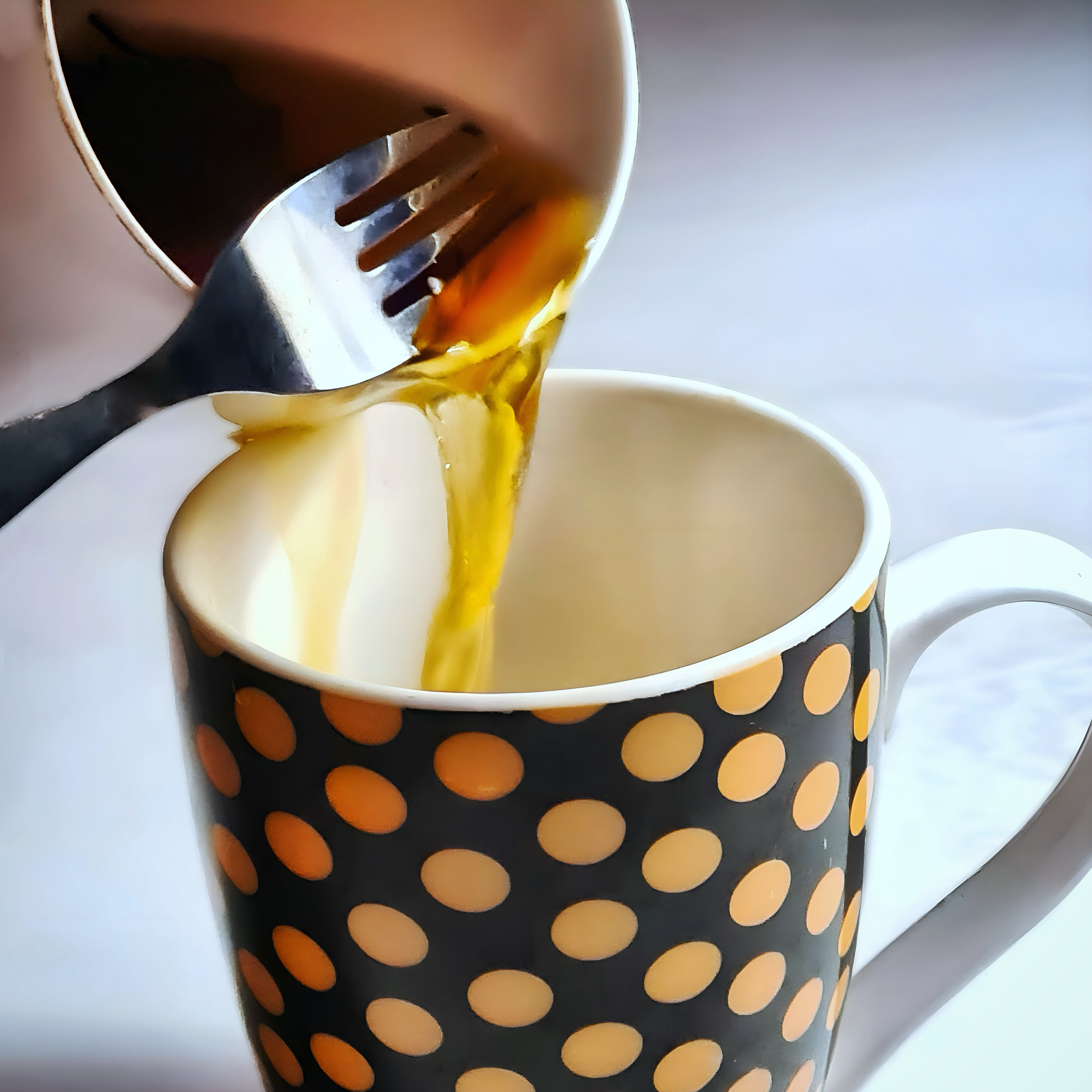Do you remember when you had your first tea? For me, I will always cherish those childhood memories drinking tea and feeling a sense of maturity as I sat with the grown-ups. However, times are changing, and parents are increasingly more health conscious with their children. In fact, parents and children alike are more commonly asking themselves the age-old question: “Should kids drink tea?”
Today we will explore this brewing topic and discover the implications for our little ones’ health, along with some recommendations to get your kids involved!

Health Benefits and Concerns for Kids Drinking Tea
Tea is not just a warm hug in a mug; it’s a liquid superhero for hydration and has a calming cape that can soothe the most energetic of minds. In fact, when kids drink tea (and grown-ups), they can actually gain a variety of health benefits. In particular, it possesses an abundance of antioxidant properties, which could be great for youngsters.
However, there’s a twist in the tealeaves – caffeine! While it’s the kickstart for many grown-ups, in children, it could lead to a jittery mess. And let’s not forget, too much tea could potentially affect their tooth enamel!
Although, thats not to say kids ‘shouldn’t’ drink tea. Drinking tea can actually be great for children, when done properly. So, here are some of the main health benefits and concerns to consider when thinking about your kids tea routine:
Potential Health Benefits
Tea, particularly herbal varieties, can offer several potential health benefits for children. While there are many more benefits of tea, here as some of the best things for kids:
- Antioxidants: Tea is rich in antioxidants, which can help protect the body’s cells from damage by harmful molecules known as free radicals. These antioxidants can detox the body, support overall health and support well-being.
- Hydration: Tea is mostly water, which is essential for maintaining hydration. Proper hydration is crucial for bodily functions, including digestion and temperature regulation.
- Calming Effects: Certain herbal teas, like chamomile, are known for their natural calming properties, which can help children relax and may improve sleep quality.
Considerations and Concerns
Obviously, there are some drawbacks when kids drink tea. Tea can be beneficial, but it’s also important to consider potential concerns:
- Caffeine Content: Many teas contain caffeine, which can have various effects on children, including impacting their sleep patterns and causing restlessness or anxiety. It’s best to choose teas with low or no caffeine for children.
- Dental Health: Tea can affect dental health. Dark teas can stain teeth, and sweetened teas can contribute to tooth decay, especially if dental hygiene is not maintained. Find out more about tea and oral health.
- Interactions with Medications: Some teas may interact with medications. For example, certain compounds in tea can alter the effectiveness of drugs. Always consult with a healthcare provider before introducing tea to a child who is taking medication.
Do you get worn out looking after your kids? Find out which tea has the most caffeine for a refreshing energy boost!
Age-Appropriate Tea Consumption for Children
So, now you might be wondering, “when is the right time to introduce our kiddos to the tea party?” Well, there are many different things to consider when picking the best time for kids to drink tea. Personally, I suggest waiting until the young ones can appreciate the flavors and understand the concept of moderation. Of course, it’s up to you to make the decision on what’s best for your children!
However, introducing tea to children is a decision that should be made with careful consideration of their age and developmental stage. Here are some detailed points to make your decision easier:

Understanding Children’s Development
- Digestive System: Children have immature digestive systems that are still developing the ability to process complex foods and beverages. Introducing tea too early may lead to digestive discomfort or interfere with nutrient absorption.
- Taste Preferences: Children’s taste preferences are still forming. Introducing bitter or strong-flavored teas might be off-putting and discourage them from trying other healthy foods and drinks.
- Hydration Needs: Young children’s bodies require adequate hydration for growth and development. While tea can contribute to fluid intake, it should not replace water or milk, which are essential in a child’s diet.
Health Organization Guidelines
- World Health Organization (WHO): The WHO does not provide specific guidelines on tea consumption for kids to drink, but it emphasizes the importance of a balanced diet and limiting caffeine intake.
- American Academy of Pediatrics (AAP): The AAP suggests avoiding caffeine-containing beverages for children under 12 and advises caution with caffeine for adolescents.
Caffeine Considerations
- Caffeine Sensitivity: Children are more sensitive to caffeine than adults. Even small amounts can affect their sleep, mood, and behavior.
- Recommended Limits: For children who consume caffeine, it’s recommended to limit their intake. For example, kids aged 4-6 should have no more than 45 milligrams of caffeine per day in their drink, which is about the amount in a typical cup of green tea.
Cultural and Family Practices
- Family Habits: In many cultures, tea is a part of daily life and kids are introduced to the drink at a young age. Families should consider their cultural practices and how tea fits into their dietary habits.
- Modeling Moderation: Parents and caregivers can model moderate tea consumption and help children understand the importance of balance in their diet.
Introducing Tea to Kids to Drink: A Thoughtful Approach
Before we get into the best drink choices of tea for kids, we’ll talk you through a simplistic approach you could take. Particularly, If you want to introduce your child to tea, but worry about the negative effects, you can try this approach for a smooth introduction!
Firstly, you will want to assess whether the child is ready to try a new beverage. This includes considering their age, current diet, and any known food sensitivities or allergies. Once everything is ok, you can try our these tips:

1. Starting with Herbal Teas
Herbal teas are the safest option for children because they are naturally caffeine-free and come in a variety of flavors that are often well-received by young taste buds. Additionally, you can improve the taste with a teaspoon of sugar, if your diet for them allows it. You could try herbal teas such as:
- Chamomile: Known for its calming properties, it can be a good choice for a pre-bedtime ritual.
- Peppermint: May aid digestion and has a refreshing taste.
- Fruit Infusions: Offer a naturally sweet flavor that can be appealing to children without the need for added sugars.
2. Gradual Introduction
Introduce tea gradually into the child’s diet. Start with a weak brew and a small quantity to allow the child to get used to the taste and to monitor for any adverse reactions. Once they are in a routine, you could try increasing the strength and quantities, if desired. Moreover, you could even try slowly introducing low-caffeine teas when you think the time is right (more on that later).
3. Creating a Positive Experience
Make the first experience of tea drinking positive. This could involve letting the child choose their own cup or having a special tea time together. For me, tea-time was always an enjoyable social occasion, where the family would sit together with the kids, drink, and chat or play board games. You could possibly try something similar and make it fun for the both of you!
4. Educating on Tea Culture
Use the introduction of tea as an opportunity to educate the child about the cultural significance of tea. Share stories or facts about how tea is enjoyed in different parts of the world.
One of the most interesting and unique stories you can talk about is the amazing origins of tea; a mythical legend about an ancient Chinese emperor who accidentally discovered tea when a leaf fell in his pot!
5. Monitoring and Adjusting
After the initial introduction, monitor the kids response to the tea when they drink it. Look for signs of enjoyment, as well as any negative reactions such as stomach upset or changes in sleep patterns. Adjust the type of tea, preparation method, and frequency accordingly.
6. Encouraging Autonomy
As the child grows older, encourage them to learn about and prepare their own tea. This fosters independence and helps them develop a healthy relationship with food and beverages. You can make it a fun experience and give them the challenge of remembering how everyone likes their tea!
Involving Healthcare Professionals:
If there are any concerns about how tea may affect the child’s health, consult with a pediatrician or a registered dietitian. They can provide guidance tailored to the child’s specific needs.
The Best Types of Tea Suitable for Kids to Drink
Now, let’s dive into the list of suitable tea choices for kids to drink. Of course, herbal teas take the center stage – since they’re caffeine-free. However, it’s completely fine if you want to introduce caffeinated teas, but just be cautious of the caffeine content! There are certain teas which have less caffeine which could be more suitable for kids.
Personally, when it comes to selecting teas for children, I believe the key is to find a tea that offers a pleasant taste without the need for added sugars, whether that be herbal or caffeinated. Here are some of the best options:
Herbal Teas

Herbal tea is the go-to choice for kids because they are naturally free of caffeine and come in a variety of drink flavors that appeal to young palates. Here is a full list of herbal teas to try, otherwise you could try some of these simple and healthy options to begin with:
- Chamomile Tea: Known for its calming properties, chamomile tea can be a good option for children, especially before bedtime. It may help soothe and relax, promoting better sleep.
- Peppermint Tea: With its refreshing flavor, peppermint tea can help settle an upset stomach and is often enjoyed by children.
- Fruit Infusions: These teas, made from dried fruits, offer a naturally sweet taste and are rich in flavors. They are a great way to introduce children to the world of tea without the need for added sugars.
- Rooibos Tea: Also known as red bush tea, is naturally caffeine-free and rich in antioxidants. It has a sweet, nutty flavor and is often enjoyed by children.
Decaffeinated Teas

While traditional teas like black, green, or white tea naturally contain caffeine, decaffeinated versions are available. These teas undergo a process to remove most of the caffeine, making them more suitable for children. You can find out everything you need to know about decaf teas here. Otherwise, you could try out these common types of decaf tea:
- Decaffeinated Green Tea: This tea retains the antioxidants found in green tea but without the caffeine, making it a healthier choice for kids.
- Decaffeinated Black Tea: It offers the same rich flavor as regular black tea but is safer for children due to the reduced caffeine content.
Caffeinated teas (with lower caffeine content)

While caffeine is generally recommended to be limited in children’s diets, there are some teas with lower caffeine content that can be considered for occasional consumption by older children and adolescents. Here are a few options to try:
1. Green Tea
Green tea contains a moderate amount of caffeine and is rich in antioxidants. It can offer a gentle energy boost without the high caffeine levels found in coffee or black tea.
2. White Tea
White tea is the least processed of all teas and has a lower caffeine content compared to other traditional teas. It has a delicate flavor and can be a good introduction to caffeinated teas for older children.
3. Oolong Tea
Oolong tea has a caffeine content that falls between green and black tea. It’s known for its diverse flavors and can be a suitable option for adolescents looking to explore different types of tea.
Preparing Tea for Kids: A Detailed Guide
To the everyday person, brewing tea is a simple task. However, for the tea connoisseurs alike, brewing tea is an art form that requires patience and perfection! You can read our article on how exactly to prepare and brew the perfect cuppa‘.
As for kids, we have included a tailored tea brewing guide below, specifically for kids to drink. This will take into consideration certain things like temperature, steeping time, serving size, etc, ensuring that tea-time is a safe, enjoyable, and enriching experience for children!

1. Choosing the Right Tea
- Opt for Herbal and Decaffeinated: Select herbal or decaffeinated teas as they are caffeine-free and generally considered safe for children.
- Flavor Matters: Choose teas with flavors that are likely to appeal to children, such as fruity or mild herbal teas.
2. Water Temperature and Quality
- Cooler Water: Use water that’s cooler than what you would use for adult teas. Aim for around 175°F (80°C) to avoid burning their sensitive mouths and to minimize caffeine extraction in decaffeinated teas.
- Filtered Water: Consider using filtered water to ensure the tea is free from any impurities that could affect the taste or health quality.
3. Steeping Time
- Shorter Steeping: Steep the tea for a shorter time than recommended for adults. This will produce a milder tea that’s more suitable for a child’s palate and will reduce any residual caffeine content. A steeping time of 1-3 minutes is usually sufficient.
- Re-steeping Tea: Did you know, certain tea are suitable for re-steeping? Especially with loose leaf tea, you can steep the same tea multiple times. If your child is a bit of a tea addict, you could try this to save on tea costs. Check out our guide on The Art of Re-Steeping: How to Enjoy Multiple Cups of Flavour.
4. Sweetening the Tea
- Natural Sweeteners: If sweetness is desired, opt for natural sweeteners like honey (for children over one year old due to the risk of botulism in infants) or a small amount of sugar. Discover the The Best Sweeteners for Tea: How to Find Your Sweet Spot. You can also use fruit slices or a splash of juice to add flavor without too much sweetness.
- Avoid Artificial Sweeteners: It’s best to avoid artificial sweeteners, as their long-term effects on children are not well understood.
5. Serving Size and Frequency
- Small Portions: Serve tea in small portions appropriate for the child’s age and size. A small cup or a half-cup serving can be a good start.
- Occasional Treat: Treat tea as an occasional beverage rather than a daily habit, especially if it contains caffeine.
6. Safety Considerations
- Supervision: Depending on the age, always supervise children while they’re drinking tea to prevent spills and burns.
- Teach About Temperature: Educate children on the importance of checking the temperature before drinking to avoid burns.
6. Involving Kids in the Process
- Tea-Making as an Activity: Involve children in the tea-making process. Let them choose their tea and help with adding the water or sweetener. This can make tea time a fun and educational experience.
- Cultural Learning: Use tea preparation as an opportunity to teach children about different cultures and their tea-drinking traditions.
Parental Guidance and Monitoring in Children’s Tea Consumption
Parental guidance and monitoring are key to ensuring that kids drink tea in a safe and healthy manner. By being informed, setting boundaries, and involving children in the process, parents can help foster a positive and educational tea-drinking experience.

The Role of Parents
Parents play a pivotal role in introducing and monitoring their children’s tea consumption. It’s important for parents to:
- Educate Themselves: Understand the types of teas, their benefits, and potential risks. Knowledge about caffeine content and appropriate teas for children is essential.
- Set Boundaries: Establish clear rules about when and how much tea their children can drink. This includes setting limits on caffeinated teas and ensuring moderation.
Monitoring Consumption
- Observe Reactions: Parents should watch for any adverse reactions in their children after consuming tea, such as restlessness, sleep disturbances, or digestive issues.
- Track Habits: Keep an eye on how often and how much tea their children are drinking. This is particularly important for teas that contain caffeine.
Encouraging Healthy Habits
- Promote Variety: Encourage children to drink a variety of beverages, not just tea. This helps ensure they get a balanced intake of fluids and nutrients.
- Teach Moderation: Instill the concept of moderation in children’s diets, including their tea consumption.
Safety Precautions
- Prevent Burns: Ensure that tea is served at a safe temperature to prevent scalding.
- Safe Storage: Keep tea bags and loose-leaf teas out of reach of young children to prevent accidental ingestion or choking hazards.
Involvement in Preparation
- Involve Children: Include children in the tea selection and preparation process, teaching them how to make tea safely.
- Cultural Appreciation: Use tea time as an opportunity to teach children about different cultures and traditions associated with tea.
Conclusion
So, should kids drink tea? It’s a resounding “Yes, but with a spoonful of wisdom!” Tea can be a delightful addition to a child’s day, sprinkled with benefits and laughter. Just tailor the experience to their age, health, and taste buds, and you’ll have a merry time in tealand.
As we come to the end, it’s clear that the question of whether kids should drink tea is not just about quenching thirst—it’s about nurturing health, fostering family traditions, and sipping on life’s simple pleasures. Tea can be a delightful addition to a child’s diet when chosen wisely and consumed responsibly. So go ahead, don’t be afraid, and let your kids into the world of tea!





Leave a Comment